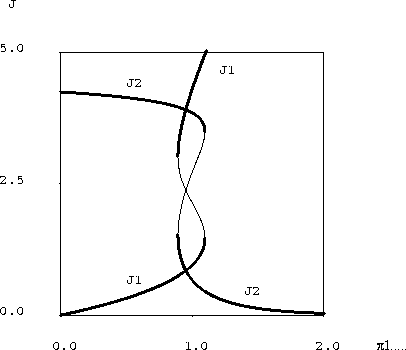 and
and  .
Replacing profit
.
Replacing profit  in
equations 11 and 12 by respectively
in
equations 11 and 12 by respectively  and
and  , equation
13 becomes:
, equation
13 becomes:
Another important qualitative result of the mean field approach is the existence of hysteresis effects: buyers might still have a strong preference for one shop that offered good deals in the past, even though the current deals they offer are less interesting than those now offered by other shops.
Let us come back once more to the case of two
shops 1 and 2, and now suppose that they offer different prices and hence
different profits  and
and  .
Replacing profit
.
Replacing profit  in
equations 11 and 12 by respectively
in
equations 11 and 12 by respectively  and
and  , equation
13 becomes:
, equation
13 becomes:
When  is above
is above
 , the three intersections remain
as long as the difference in profits
is not too large. Which of the two extreme intersections is actually
reached by the learning dynamics depends on initial conditions.
, the three intersections remain
as long as the difference in profits
is not too large. Which of the two extreme intersections is actually
reached by the learning dynamics depends on initial conditions.

Figure 1: Hysteresis of fidelities.
Plot of both fidelities versus  , the profit to
be obtained from shop number 1 when
, the profit to
be obtained from shop number 1 when  the profit to
be obtained from shop number 2 is held equal to 1.
(
the profit to
be obtained from shop number 2 is held equal to 1.
( and
and  ).
The thick lines correspond to stable equilibria for both fidelities,
).
The thick lines correspond to stable equilibria for both fidelities,
 and
and  ,
and the thin lines, existing when
,
and the thin lines, existing when  is around
is around  ,
to unstable equilibria.
In the three solutions region, the larger value of
,
to unstable equilibria.
In the three solutions region, the larger value of
 is reached from initial conditions when
is reached from initial conditions when  is already large.
Thus if
is already large.
Thus if  is decreased from above one,
is decreased from above one,  is kept large
(and
is kept large
(and  is kept small)
even when
is kept small)
even when  becomes less than
becomes less than  . The stability of
this metastable attractor is lost when
. The stability of
this metastable attractor is lost when  .
In a symmetrical manner, the high
.
In a symmetrical manner, the high  attractor existing at low
attractor existing at low
 can be maintained up to
can be maintained up to  .
(the figure was drawn using GRIND software, De Boer 1983).
.
(the figure was drawn using GRIND software, De Boer 1983).
Thus, as illustrated on figure 1, buyers can remain faithful to a shop asking for a higher price (which results in a lower profit for the buyer), provided that they became attached to this shop when it practiced a lower price. When the most often frequented shop changes its prices, the fidelity to that shop describes the upper branch of the fidelity versus profit curve (figure 1). The fidelity remains on the upper branch as long as it exists, i.e. until the point where the slope is vertical. When profit decreases beyond that level, a sudden and discontinuous transition to the lower branch occurs. This is the point when customers change their policy and visit the other shop. But, if the first shop reverses its high price/low buyer profit policy when fidelity is on the lower branch, the transition to the higher branch only occurs when the slope of the lower branch becomes vertical, i.e at a higher profit than for the downward transition.
A consequence of this phenomenon, is that in order to attract customers
who are faithful to another shop, a challenger has to offer a profit
significantly
greater than the profit offered by the well established shop: when
preference coefficients have reached equilibrium in the ordered regime,
customers switch only for differences in profits corresponding
to those where the slopes of the curves  in figure 3
are vertical
(i.e. not when profits are equalised!!). In other words, economic
rationality (i.e. choosing the shop offering the best deal)
is not ensured in the region where hysteresis occurs.
in figure 3
are vertical
(i.e. not when profits are equalised!!). In other words, economic
rationality (i.e. choosing the shop offering the best deal)
is not ensured in the region where hysteresis occurs.